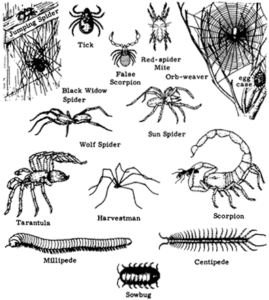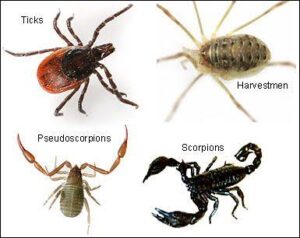Back to: ZOOLOGY 200 Level
WELCOME TO CLASS
Today, we’re going to explore some fascinating creatures from the class Arachnida: scorpions, spiders, and ticks. These animals may seem intimidating to some, but they play incredibly important roles in ecosystems. Let’s dive into their unique characteristics, behaviours, and significance.
Scorpions, Spiders, Ticks
Scorpions: The Ancient Predators
Scorpions are predatory arachnids known for their distinctive appearance—sharp pincers and a long, curved tail topped with a venomous stinger. These creatures have been around for hundreds of millions of years and are found in a variety of habitats, from deserts to forests.

Scorpions primarily use their pincers to capture prey, which includes insects and other small animals. After capturing their prey, scorpions inject venom into them using their stinger, which immobilises or kills the prey. They are nocturnal hunters, spending most of the day hiding in burrows or crevices to avoid the heat of the sun.
In some regions, like parts of Africa and the Middle East, scorpions are venomous enough to pose a threat to humans, but most species are harmless. They have adapted to survive in harsh environments, such as deserts, by conserving water and regulating their body temperature.
Spiders: Master Builders and Hunters
Spiders are one of the most diverse and widely distributed groups of arachnids. With over 45,000 species, spiders are found in nearly every habitat on Earth, except for the oceans. What sets spiders apart is their ability to produce silk, which they use to build webs, capture prey, and protect their eggs.
Spiders have specialised mouthparts called chelicerae, which are used to inject venom into their prey. This venom helps break down the prey’s tissues, allowing the spider to suck up the liquid. Spiders vary in their hunting strategies: some build elaborate webs to catch flying insects, while others are active hunters that chase down or ambush their prey.
While some spiders can be venomous and dangerous to humans, such as the black widow or brown recluse, the majority of spiders are harmless and help control insect populations, making them valuable in pest control.
Ticks: The Parasitic Arachnids
Ticks are small, blood-sucking arachnids that are often found on animals like mammals, birds, and sometimes reptiles. They are known for their ability to attach to their host for extended periods and feed on blood. While feeding, ticks can transmit diseases such as Lyme disease and Rocky Mountain spotted fever, making them a significant concern for both humans and animals.

Ticks have specialised mouthparts called hypostomes that allow them to anchor firmly to their host. Once attached, they will remain on their host for days or even weeks, gradually engorging themselves with blood. This parasitic behaviour is part of what makes ticks both dangerous and fascinating.
There are two main families of ticks: Ixodidae (hard ticks) and Argasidae (soft ticks). Hard ticks are the most well-known, and their bites are typically visible to the naked eye, while soft ticks are often hidden under the skin of their hosts.
Summary
- Scorpions are nocturnal predators with pincers and a venomous stinger, found in various habitats including deserts.
- Spiders are famous for their ability to spin silk, which they use for hunting and building webs.
- Ticks are parasitic arachnids that feed on blood and can transmit diseases to their hosts.
- Despite their sometimes dangerous nature, arachnids play crucial roles in ecosystems, from pest control to parasitism.
Evaluation
- What are the key features of scorpions that help them catch prey?
- How do spiders use silk in their daily lives?
- Explain the role of ticks in the spread of diseases.
- What is the difference between hard and soft ticks?
You’ve just learned about some of the most interesting and important arachnids on the planet! Keep exploring, and remember that even the creatures we might fear have valuable roles in nature. You’re doing an amazing job—let’s continue this exciting journey together!
